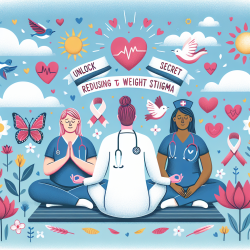Introduction
In the realm of mental health, the implementation of evidence-based practices (EBPs) for suicide prevention is crucial. However, many clinicians face significant barriers, primarily due to anxiety and low self-efficacy, which hinder the effective use of these practices. The research article titled "An exposure-based implementation strategy to decrease clinician anxiety about implementing suicide prevention evidence-based practices: protocol for development and pilot testing (Project CALMER)" provides a novel approach to addressing these barriers.
Understanding Clinician Anxiety
Clinician anxiety often stems from fears of liability, misjudging patient risk, and inadequate intervention time. This anxiety can lead to avoidance of suicide screening and intervention, which are critical components of suicide prevention. The research highlights that this avoidance is a maladaptive response, which can be addressed through targeted strategies.
The Role of Exposure-Based Implementation Strategy (EBIS)
Project CALMER introduces an Exposure-Based Implementation Strategy (EBIS) to directly target and reduce clinician anxiety. This strategy is built on the principles of exposure therapy, which involves gradually confronting feared scenarios to build tolerance and reduce anxiety. The EBIS is designed to enhance clinician self-efficacy and improve the implementation of suicide prevention EBPs.
Key Components of EBIS
- Psychoeducation: Educating clinicians about the role of anxiety in EBP delivery and the cycle of avoidance.
- Assessment and Hierarchy-Building: Identifying specific fears and ranking them to tailor exposure practice.
- Guided Practice: Engaging in in vivo or imaginal exposure with trained actors to confront and manage anxiety.
- Relapse Prevention: Applying learned strategies to real-life clinical practice and maintaining gains through ongoing consultation.
Implementation and Pilot Testing
The study employs a participatory design method to develop and refine the EBIS in collaboration with a stakeholder advisory board. The pilot testing involves 40 community mental health clinicians who are randomized to receive either Implementation as Usual (IAU) or IAU plus EBIS. The primary outcomes focus on the acceptability and feasibility of EBIS, while secondary outcomes assess clinician anxiety, self-efficacy, and EBP adoption.
Encouraging Further Research
The findings from Project CALMER provide valuable insights into the feasibility and utility of targeting clinician anxiety and self-efficacy. However, further research is needed to explore the long-term effects of EBIS and its application to other anxiety-provoking clinical practices. Clinicians are encouraged to delve deeper into this research to enhance their practice and improve patient outcomes.
To read the original research paper, please follow this link: An exposure-based implementation strategy to decrease clinician anxiety about implementing suicide prevention evidence-based practices: protocol for development and pilot testing (Project CALMER).










